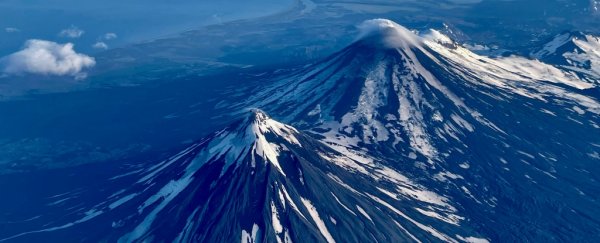Three volcanoes in the Alaskan chain of Aleutian islands are currently erupting, and two others are rumbling with disquiet.
According to a report by NBC, it's been at least seven years since three Aleutian volcanoes erupted simultaneously. This increased volcanic activity, at this point, is not causing any disruptions, but it is an interesting situation; since volcanoes can be unpredictable, scientists are keeping a careful watch.
The Great Sitkin volcano, Mount Pavlof, and the Semisopochnoi volcano are all at an orange volcano alert level as of Sunday 15 August, according to the Alaska Volcano Observatory.
This means that eruptions are currently underway, but they're relatively small, rumbly ones with minimal ash.
Only minute amounts of ash have been detected at Mount Pavlof and Semisopochnoi, and none from Great Sitkin. However, lava is flowing from Great Sitkin, and large seismic tremors and several explosions have been detected at Semisopochnoi.
In addition, Mount Cleveland and the volcanic complex on Atka have been showing signs of activity - increased heat under Mount Cleveland, and small earthquakes under Atka. Both are at a yellow volcano alert level.
Although such simultaneous volcanic activity in the Aleutians is uncommon, it's not unheard of. The Aleutian Arc is a chain of volcanoes spread along the subduction boundary between two tectonic plates - the Pacific Plate pushing beneath the North American Plate. The chain stretches from the Alaskan Peninsula to the Kamchatka Peninsula in Russia.
Often when volcanoes erupt, other nearby volcanoes in close proximity can be roused, but it's not always clear why. The Aleutian Arc is home to a different kind of mystery.
In 1996, volcanic and seismic activity was spread across 870 kilometers (540 miles) of the arc, which scientists concluded had to be more than coincidental, although the trigger is unknown.
In this case, it's not entirely clear what's going on either. Nearly 290 kilometers (180 miles) span between the two outermost volcanoes in this spate of activity, Great Sitkin and Semisopochnoi.
Last year, researchers found that a collection of volcanoes along the Aleutian Arc may be part of a larger supervolcano, but only one of the currently rumbly beasts, Mount Cleveland, is among the specified group.
Although there's nothing to worry about at this point, the event could turn out to be very scientifically interesting.
Geologists and volcanologists will no doubt be monitoring the situation to see if they can find a link to earlier outbreaks of simultaneous activity, and to try to learn more about this mysterious arc of volcanoes.
